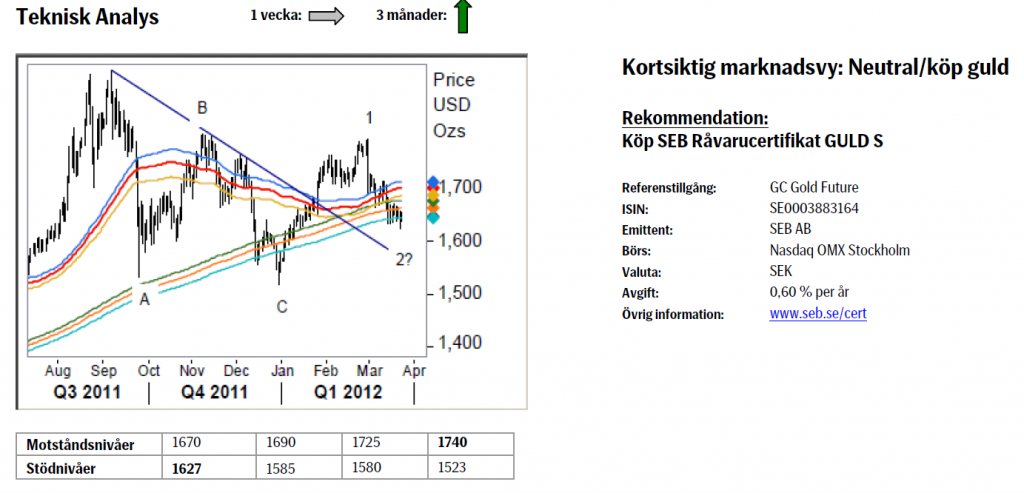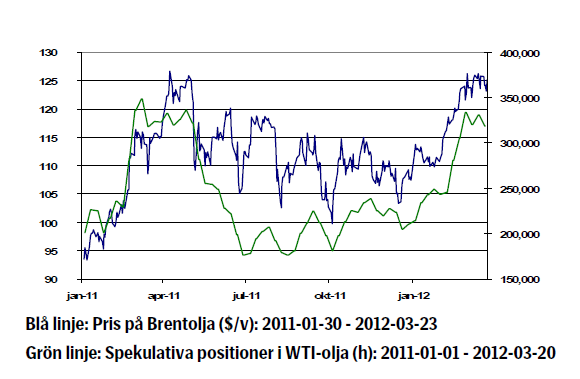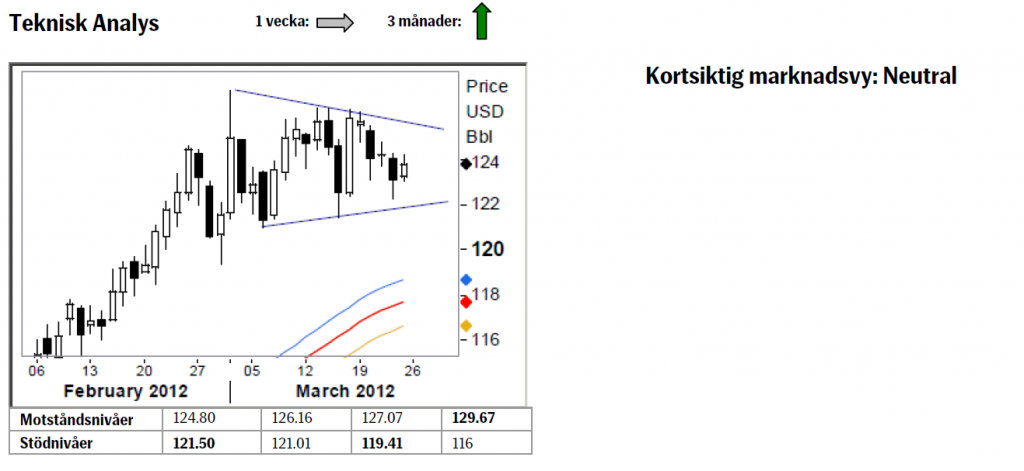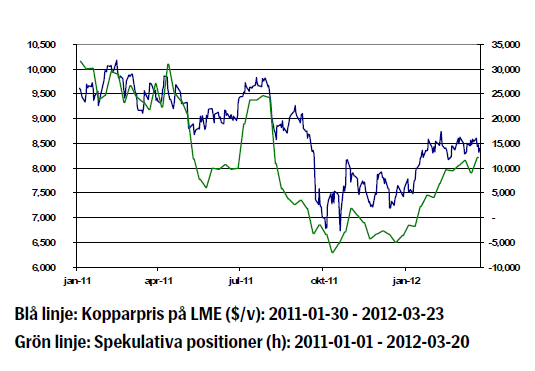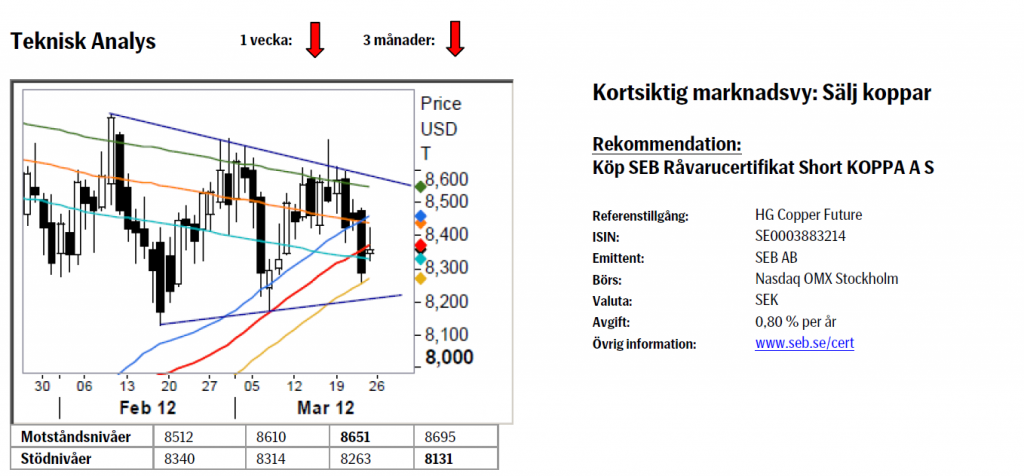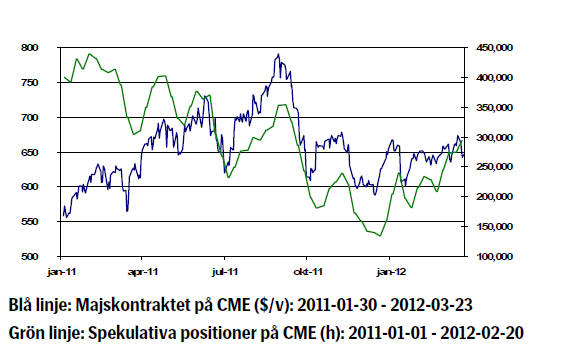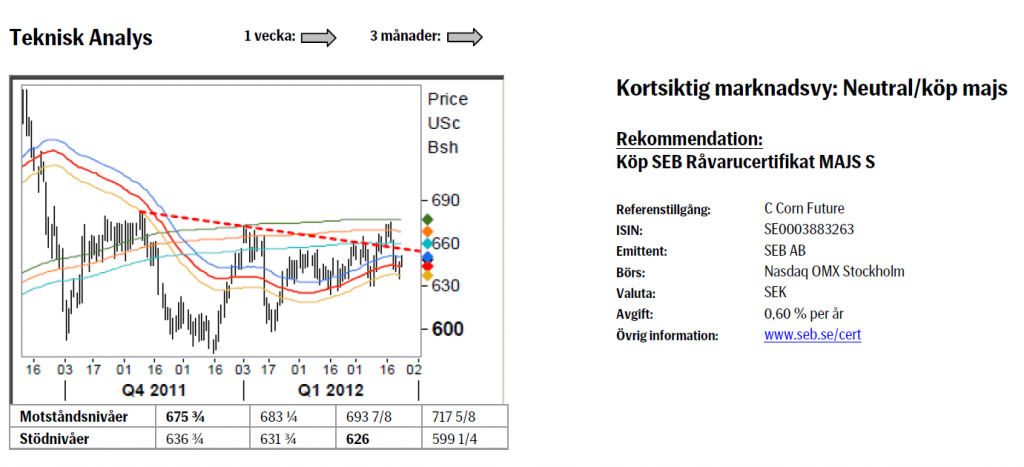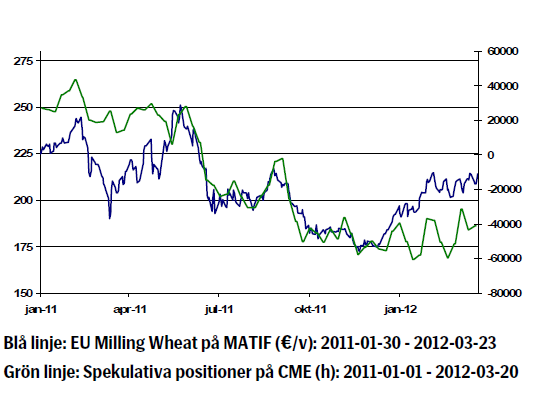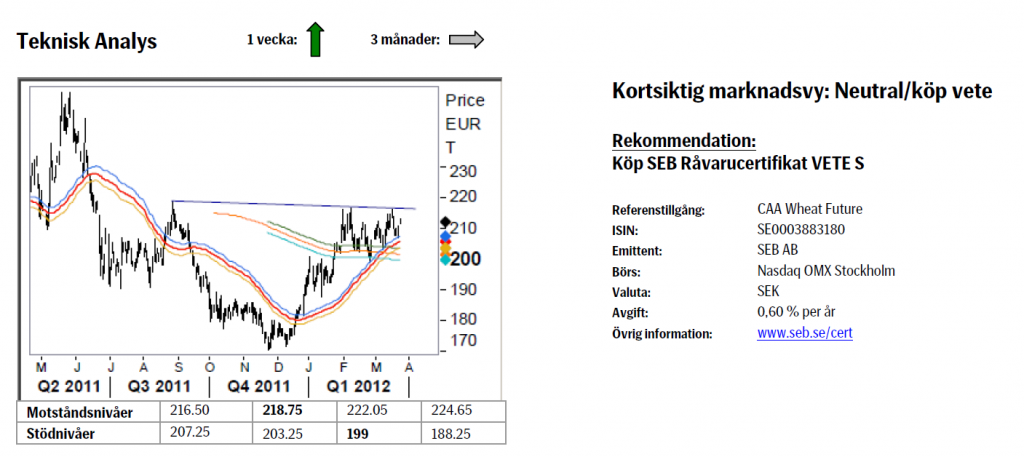Analys
SEB – Råvarukommentarer vecka 13 2012
Sammanfattning: Föregående vecka
- Brett råvaruindex: -1,33 %
UBS Bloomberg CMCI TR Index - Energi: -0,91 %
UBS Bloomberg CMCI Energy TR Index - Ädelmetaller: +0,11 %
UBS Bloomberg CMCI Precious Metals TR Index - Industrimetaller: -2,67 %
UBS Bloomberg CMCI Industrial Metals TR Index - Jordbruk: -0,92 %
UBS Bloomberg CMCI Agriculture TR Index
Kortsiktig marknadsvy:
- Guld: Neutral/köp
- Olja: Neutral
- Koppar: Sälj
- Majs: Neutral/köp
- Vete: Neutral/köp
Guld
- Det grekiska parlamentet godkände på onsdagen formellt det sparpaket som var förutsättningen för ett andra räddningspaket från EU och IMF. Detta var mest en formalitet men beskedet gav stöd åt euron. Denna föll emellertid igen på torsdagen då inköpsprisindex från Tyskland var sämre än förväntat. Dollarn steg och råvaror sjönk brett. Italiens premiärminister Monti varnade i helgen för att Spanien skulle kunna utlösa en ny allvarlig kris i EMU och uppmanade landet att ta kontroll över sin statsbudget. Oron för en recession i Europa ökar.
- Guldet föll totalt 6,5 procent förra veckan. Innehavare av fysiska ETF:er minskade sina innehav och världens största guld-ETF, SPDR Gold Trust, tappade 8 ton guld.
- Från den första april i år inför Indien en fyraprocentig importskatt på guld, en åtgärd som har lett till att landets 300 000 juvelerare nu strejkar. Indien är det land i världen som importerar störst mängd guld.
- Vi bedömer att guldpriset på kort sikt sannolikt inte kommer att kunna gå undernuvarande nivåer. Vid eventuella bakslag i den globala återhämtningen kan dock priset komma upp något igen. Med detta som bakgrund förhåller vi oss svagt positiva till guldpriset denna vecka.
- Teknisk Analys: Under den senaste veckan har marknaden i princip varje dag handlat ned under 233-dagarsbandet bara för att när dagen är slut ha återvänt in i det. Beteendet visar på kontinuerligt köpande i området och framför allt torsdagens kursrörelse indikerar att säljarna nu tappat kraft. Följaktligen fortsätter vi rekommendera försiktiga köp i området (över 1725/40 mer aggressivt då vi då kan bekräfta vändningen uppåt).
Olja
- Oljepriset föll totalt med 0,5 procent förra veckan, men i fredags steg Brentpriset plötsligt tre dollar efter en rapport från Petrologistics att oljeexporten från Iran väntas sjunka betydligt i mars. Råoljeexporten från Iran verkar falla med 300 000 fat olja per dag vilket motsvarar cirka tio procent av landets totala export.
- Bränslekostnader i Kina, vilka styrs direkt av kinesiska myndigheter, har höjts. Detta för att rädda landets raffinaderier vilka köper olja på rörligt pris men slutprodukter till fast pris. Detta medför i dagsläget ekonomiska problem för dem och bidrog till att oljepriset föll då man räknar med att efterfrågan minskar. Kina är världens näst största oljekonsument.
- Trots att det för tillfället inte råder någon brist på olja i marknaden så fortsätter oron kring Iran att ge stöd åt priset och rykten och nyheter gör att priset snabbt kan stiga. En hög riskpremie finns med andra ord kvar i marknaden. Både Bernanke och Obama har uttryckt oro för att oljepriset kommer att ligga kvar på nuvarande höga nivåer. Även i Europa uttrycks oro från politikers håll och Frankrike har annonserat att man överväger att släppa lös strategiska oljereserver. USA utövar påtryckningar på Kina och Indien att de ska minska oljeimporten från Iran, för att på så sätt undgå sanktioner från USA. De minskningar som länderna gjort hittills är inte tillräckliga.
- Teknisk Analys: Vår vy är sedan förra veckan helt oförändrad och kommer att så förbli tills antingen vi bryter upp ur triangeln bekräftandes vår vy om en ny topp i 129-131-området alternativt bryter ned under 121,50, vilket skulle göra triangeln obsolet och då snarare peka på en toppformation (såsom det ju eventuellt ser ut att bli i fallet koppar).Teknisk Analys: I och med brottet över aprilkontraktets tidigare topp förstärks uppåt potentialen. Nästa givna mål ska sökas vid 129.75/131.39 området, nästa Fibonacci projektionsområde. Där ovanför återfinns också toppen från 2007, 147.50. Det är dock noterbart att i €uro termer så handlas Brentoljan nu på nya rekordnivåer.
Koppar
- Kopparpriset föll 2,18 procent förra veckan. Det största raset skedde på torsdagen då priset föll till 8262 dollar per ton, det lägsta priset på två år. Inköpsprisindex från Europa och Kina kom in på lägre nivåer än förväntat vilket ökad farhågan i marknaden att efterfrågan på koppar, främst från Kina, kommer att minska.
- Kinesiskt HSBC:s flash-PMI för mars kom in svagare än föregående månad och föll från 49.6 till 48.1, vilket innebär att index nu legat under 50-nivån fem månader i rad. Index för nya ordrar föll och sysselsättningen noterade den lägsta nivån sedan mars 2009. Ett värde under 50 innebär en kontraktion.
- Kinesisk fastighetsmarknad har kylts av något, vilket också varit avsikten med myndigheternas restriktivare penningpolitik. Ytterligare ekonomiska stimulanser är inte troliga för tillfället från kinesiska myndigheters håll, vilket verkar dämpande på kopparpriset.
- Teknisk Analys: Det eventuellt positiva triangelscenario vi skrev om förra veckan har sedan dess tappat mark givet den kraftiga (dock fortsatt inom triangeln) nedgång som skett. Sannolikheten för ett negativt utfall måste därför anses ha ökat och ett test av stödområdet dvs. feb/mar-bottnarna bör ske under nästkommande vecka.
Majs
- Förra veckan började med ett par procents nedgång, detta efter svaga exportsiffror från USA och generella uttag från investerarkollektivet. Enligt CME fanns även viss oro för att det kinesiska majspriset skulle falla tillbaka något från förra veckans rekordnivåer.
- Torsdagens svaga inköpchefsindexsiffror från Europa och Kina satte nedåttryck på råvarupriserna, detta med undantag för jordbrukssektorn. Signaler om en god global efterfrågan och frågetecken kring den kommande majsskörden i Nord- och Sydamerika tryckte exempelvis majspriset uppåt. Med andra ord var tendenserna de omvända jämfört med den första halvan av veckan.
- Vidare gick en statlig kinesisk nyhetskanal i torsdags ut med indikationer om ett växande underskott av majs de kommande åren. Även om denna typ av utspel inte påverkar priset direkt ökar den generella efterfrågan och kan på så sätt ge kortsiktigt stöd åt priset.
- Denna vecka håller vi ögonen på Argentina, där både majs och sojabönor har fått visst stöd uppåt av landets försämrade produktionsutsikter. Vi bibehåller med detta vår kortsiktigt svagt positiva syn.
- Teknisk Analys: Uppenbarligen ropade vi hej lite för tidigt förra veckan. Brottet över trendlinjen fick aldrig sin givna fortsättning, ett brott av 233-dagarsbandet och följaktligen tröttnande snart köparna och stängde en lång position. Så vi är nu tillbaka på ruta ett i det neutrala området mellan medelvärdesbanden.
Vete
- Precis som majs och sojabönor gick vetet svagt under första halvan av veckan, där framförallt investerare valde att minska andelen jordbruksråvaror i portföljerna. De gynnsamma regn som föll i de vintervetesproducerande delarna av USA förstärkte denna rörelse ytterligare.
- Även om vetepriset i Chicago återhämtade sig något under torsdagen och fredagen var det ingenting mot den rörelse vi kunde se i Paris, där priset under denna period steg med drygt 2,5 procent och innebar en knapp uppgång jämfört med veckan innan.
- Enligt analysfirman DTN väntas den kommande veckan bli ovanligt torr i stora delar av Europa, vilket kan påverka den nuvarande skörden av vintervete. Denna oro får anses vara central för den starka avslutningen förra veckan.
- Under februari månad spekulerades det en hel del kring huruvida den ryska skörden av vintervete skulle bli väsentligen sämre än vad marknaden tidigare hade förväntat sig. Det extremt kalla vädret gjorde att risken för omfattande produktionsbortfall (som en konsekvens av frostskador) ansågs vara stor. Enligt Bloomberg har nu ryska spannmålsorgan kunnat bekräfta att bortfallet inte är så stort som man befarat.
- Med den förväntade torkan i Europa som starkaste argument förhåller vi oss fortsatt svagt positiva till vetepriset på MATIF.
- Teknisk Analys: Konsolideringen ovanför medelvärdesbanden har fortsatt även den senaste veckan. Vår förväntan är att vi kommer att bryta upp över topplinjen vilken vecka som helst och att ett sådant brott i sinom tur bör kunna utlösa en rörelse upp emot majtoppen från förra året. Bara ett överraskande brott under 199 förändrar ovanstående vy.
[box]SEB Veckobrev Veckans råvarukommentar är producerat av SEB Merchant Banking och publiceras i samarbete och med tillstånd på Råvarumarknaden.se[/box]
Disclaimer
The information in this document has been compiled by SEB Merchant Banking, a division within Skandinaviska Enskilda Banken AB (publ) (“SEB”).
Opinions contained in this report represent the bank’s present opinion only and are subject to change without notice. All information contained in this report has been compiled in good faith from sources believed to be reliable. However, no representation or warranty, expressed or implied, is made with respect to the completeness or accuracy of its contents and the information is not to be relied upon as authoritative. Anyone considering taking actions based upon the content of this document is urged to base his or her investment decisions upon such investigations as he or she deems necessary. This document is being provided as information only, and no specific actions are being solicited as a result of it; to the extent permitted by law, no liability whatsoever is accepted for any direct or consequential loss arising from use of this document or its contents.
About SEB
SEB is a public company incorporated in Stockholm, Sweden, with limited liability. It is a participant at major Nordic and other European Regulated Markets and Multilateral Trading Facilities (as well as some non-European equivalent markets) for trading in financial instruments, such as markets operated by NASDAQ OMX, NYSE Euronext, London Stock Exchange, Deutsche Börse, Swiss Exchanges, Turquoise and Chi-X. SEB is authorized and regulated by Finansinspektionen in Sweden; it is authorized and subject to limited regulation by the Financial Services Authority for the conduct of designated investment business in the UK, and is subject to the provisions of relevant regulators in all other jurisdictions where SEB conducts operations. SEB Merchant Banking. All rights reserved.
Analys
Brent crude ticks higher on tension, but market structure stays soft

Brent crude has climbed roughly USD 1.5-2 per barrel since Friday, yet falling USD 0.3 per barrel this mornig and currently trading near USD 67.25/bbl after yesterday’s climb. While the rally reflects short-term geopolitical tension, price action has been choppy, and crude remains locked in a broader range – caught between supply-side pressure and spot resilience.

Prices have been supported by renewed Ukrainian drone strikes targeting Russian infrastructure. Over the weekend, falling debris triggered a fire at the 20mtpa Kirishi refinery, following last week’s attack on the key Primorsk terminal.
Argus estimates that these attacks have halted ish 300 kbl/d of Russian refining capacity in August and September. While the market impact is limited for now, the action signals Kyiv’s growing willingness to disrupt oil flows – supporting a soft geopolitical floor under prices.
The political environment is shifting: the EU is reportedly considering sanctions on Indian and Chinese firms facilitating Russian crude flows, while the U.S. has so far held back – despite Bessent warning that any action from Washington depends on broader European participation. Senator Graham has also publicly criticized NATO members like Slovakia and Hungary for continuing Russian oil imports.
It’s worth noting that China and India remain the two largest buyers of Russian barrels since the invasion of Ukraine. While New Delhi has been hit with 50% secondary tariffs, Beijing has been spared so far.
Still, the broader supply/demand balance leans bearish. Futures markets reflect this: Brent’s prompt spread (gauge of near-term tightness) has narrowed to the current USD 0.42/bl, down from USD 0.96/bl two months ago, pointing to weakening backwardation.
This aligns with expectations for a record surplus in 2026, largely driven by the faster-than-anticipated return of OPEC+ barrels to market. OPEC+ is gathering in Vienna this week to begin revising member production capacity estimates – setting the stage for new output baselines from 2027. The group aims to agree on how to define “maximum sustainable capacity,” with a proposal expected by year-end.
While the IEA pegs OPEC+ capacity at 47.9 million barrels per day, actual output in August was only 42.4 million barrels per day. Disagreements over data and quota fairness (especially from Iraq and Nigeria) have already delayed this process. Angola even quit the group last year after being assigned a lower target than expected. It also remains unclear whether Russia and Iraq can regain earlier output levels due to infrastructure constraints.
Also, macro remains another key driver this week. A 25bp Fed rate cut is widely expected tomorrow (Wednesday), and commodities in general could benefit a potential cut.
Summing up: Brent crude continues to drift sideways, finding near-term support from geopolitics and refining strength. But with surplus building and market structure softening, the upside may remain capped.
Analys
Volatile but going nowhere. Brent crude circles USD 66 as market weighs surplus vs risk

Brent crude is essentially flat on the week, but after a volatile ride. Prices started Monday near USD 65.5/bl, climbed steadily to a mid-week high of USD 67.8/bl on Wednesday evening, before falling sharply – losing about USD 2/bl during Thursday’s session.

Brent is currently trading around USD 65.8/bl, right back where it began. The volatility reflects the market’s ongoing struggle to balance growing surplus risks against persistent geopolitical uncertainty and resilient refined product margins. Thursday’s slide snapped a three-day rally and came largely in response to a string of bearish signals, most notably from the IEA’s updated short-term outlook.
The IEA now projects record global oversupply in 2026, reinforcing concerns flagged earlier by the U.S. EIA, which already sees inventories building this quarter. The forecast comes just days after OPEC+ confirmed it will continue returning idle barrels to the market in October – albeit at a slower pace of +137,000 bl/d. While modest, the move underscores a steady push to reclaim market share and adds to supply-side pressure into year-end.
Thursday’s price drop also followed geopolitical incidences: Israeli airstrikes reportedly targeted Hamas leadership in Doha, while Russian drones crossed into Polish airspace – events that initially sent crude higher as traders covered short positions.
Yet, sentiment remains broadly cautious. Strong refining margins and low inventories at key pricing hubs like Europe continue to support the downside. Chinese stockpiling of discounted Russian barrels and tightness in refined product markets – especially diesel – are also lending support.
On the demand side, the IEA revised up its 2025 global demand growth forecast by 60,000 bl/d to 740,000 bl/d YoY, while leaving 2026 unchanged at 698,000 bl/d. Interestingly, the agency also signaled that its next long-term report could show global oil demand rising through 2050.
Meanwhile, OPEC offered a contrasting view in its latest Monthly Oil Market Report, maintaining expectations for a supply deficit both this year and next, even as its members raise output. The group kept its demand growth estimates for 2025 and 2026 unchanged at 1.29 million bl/d and 1.38 million bl/d, respectively.
We continue to watch whether the bearish supply outlook will outweigh geopolitical risk, and if Brent can continue to find support above USD 65/bl – a level increasingly seen as a soft floor for OPEC+ policy.
Analys
Waiting for the surplus while we worry about Israel and Qatar

Brent crude makes some gains as Israel’s attack on Hamas in Qatar rattles markets. Brent crude spiked to a high of USD 67.38/b yesterday as Israel made a strike on Hamas in Qatar. But it wasn’t able to hold on to that level and only closed up 0.6% in the end at USD 66.39/b. This morning it is starting on the up with a gain of 0.9% at USD 67/b. Still rattled by Israel’s attack on Hamas in Qatar yesterday. Brent is getting some help on the margin this morning with Asian equities higher and copper gaining half a percent. But the dark cloud of surplus ahead is nonetheless hanging over the market with Brent trading two dollar lower than last Tuesday.

Geopolitical risk premiums in oil rarely lasts long unless actual supply disruption kicks in. While Israel’s attack on Hamas in Qatar is shocking, the geopolitical risk lifting crude oil yesterday and this morning is unlikely to last very long as such geopolitical risk premiums usually do not last long unless real disruption kicks in.
US API data yesterday indicated a US crude and product stock build last week of 3.1 mb. The US API last evening released partial US oil inventory data indicating that US crude stocks rose 1.3 mb and middle distillates rose 1.5 mb while gasoline rose 0.3 mb. In total a bit more than 3 mb increase. US crude and product stocks usually rise around 1 mb per week this time of year. So US commercial crude and product stock rose 2 mb over the past week adjusted for the seasonal norm. Official and complete data are due today at 16:30.
A 2 mb/week seasonally adj. US stock build implies a 1 – 1.4 mb/d global surplus if it is persistent. Assume that if the global oil market is running a surplus then some 20% to 30% of that surplus ends up in US commercial inventories. A 2 mb seasonally adjusted inventory build equals 286 kb/d. Divide by 0.2 to 0.3 and we get an implied global surplus of 950 kb/d to 1430 kb/d. A 2 mb/week seasonally adjusted build in US oil inventories is close to noise unless it is a persistent pattern every week.
US IEA STEO oil report: Robust surplus ahead and Brent averaging USD 51/b in 2026. The US EIA yesterday released its monthly STEO oil report. It projected a large and persistent surplus ahead. It estimates a global surplus of 2.2 m/d from September to December this year. A 2.4 mb/d surplus in Q1-26 and an average surplus for 2026 of 1.6 mb/d resulting in an average Brent crude oil price of USD 51/b next year. And that includes an assumption where OPEC crude oil production only averages 27.8 mb/d in 2026 versus 27.0 mb/d in 2024 and 28.6 mb/d in August.
Brent will feel the bear-pressure once US/OECD stocks starts visible build. In the meanwhile the oil market sits waiting for this projected surplus to materialize in US and OECD inventories. Once they visibly starts to build on a consistent basis, then Brent crude will likely quickly lose altitude. And unless some unforeseen supply disruption kicks in, it is bound to happen.
US IEA STEO September report. In total not much different than it was in January
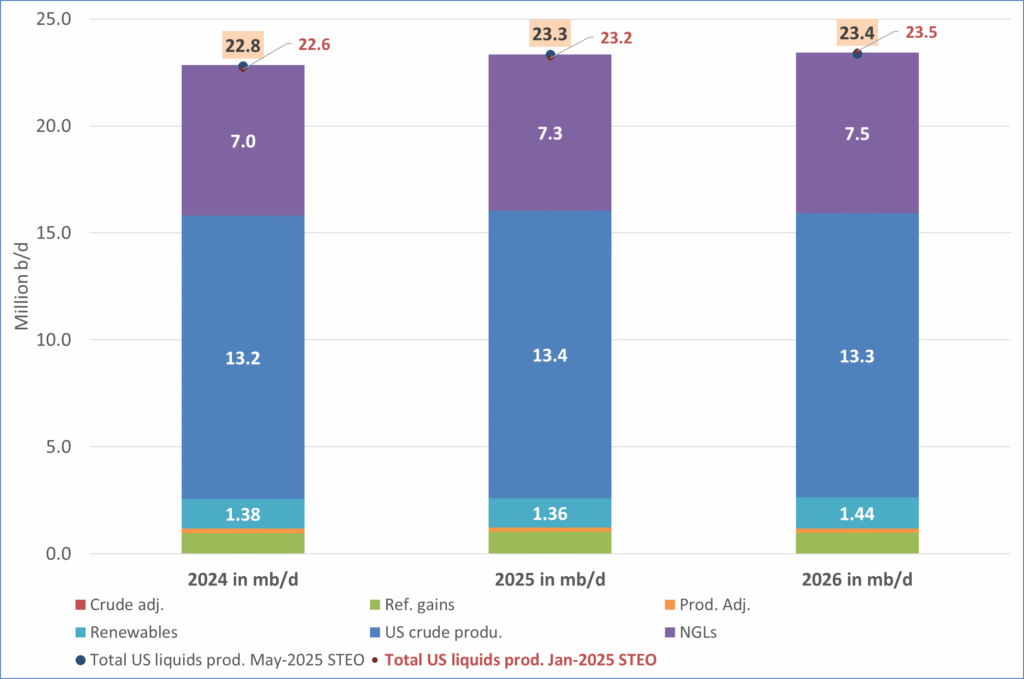
US IEA STEO September report. US crude oil production contracting in 2026, but NGLs still growing. Close to zero net liquids growth in total.
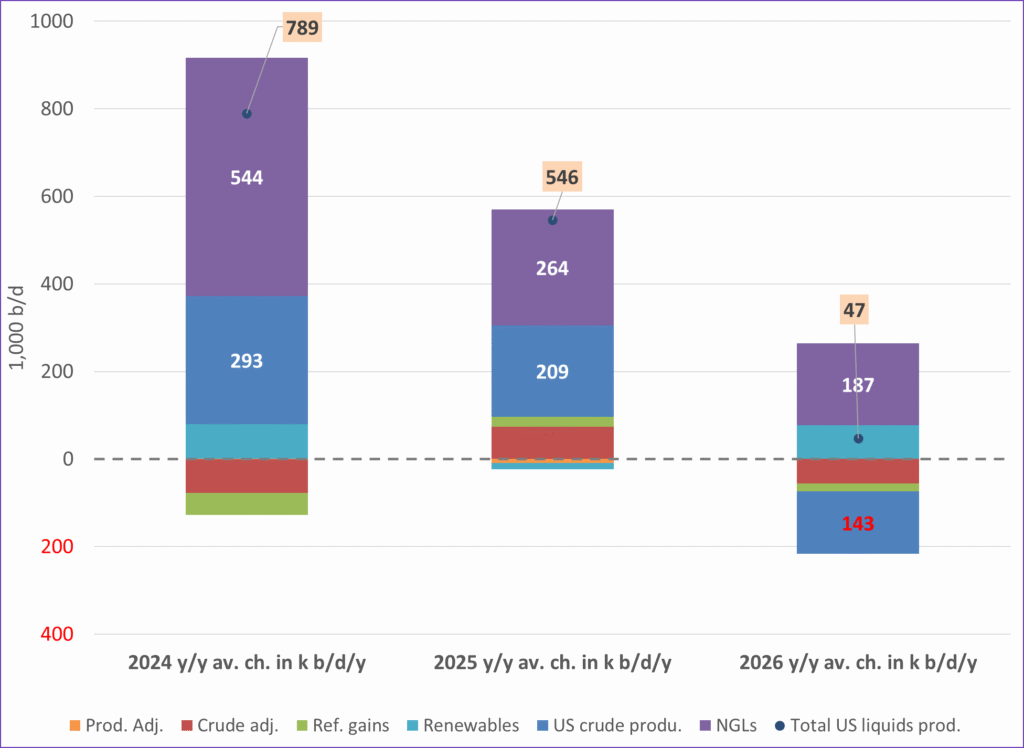
-

 Nyheter4 veckor sedan
Nyheter4 veckor sedanMeta bygger ett AI-datacenter på 5 GW och 2,25 GW gaskraftverk
-
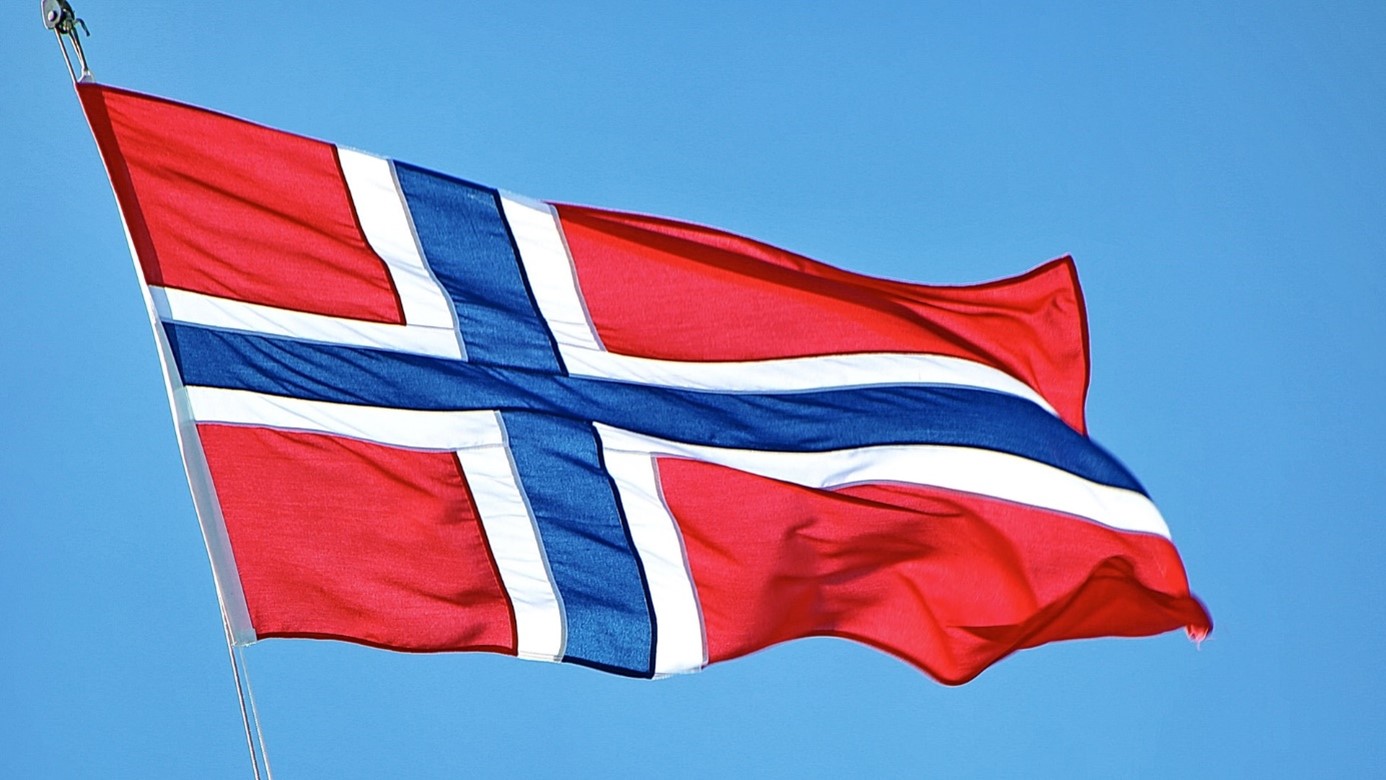
 Nyheter4 veckor sedan
Nyheter4 veckor sedanAker BP gör ett av Norges största oljefynd på ett decennium, stärker resurserna i Yggdrasilområdet
-

 Nyheter4 veckor sedan
Nyheter4 veckor sedanSommarens torka kan ge högre elpriser i höst
-

 Analys4 veckor sedan
Analys4 veckor sedanBrent edges higher as India–Russia oil trade draws U.S. ire and Powell takes the stage at Jackson Hole
-

 Nyheter3 veckor sedan
Nyheter3 veckor sedanMahvie Minerals är verksamt i guldrikt område i Finland
-

 Analys4 veckor sedan
Analys4 veckor sedanIncreasing risk that OPEC+ will unwind the last 1.65 mb/d of cuts when they meet on 7 September
-
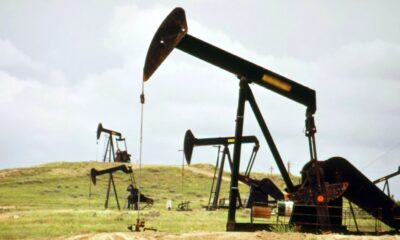
 Nyheter3 veckor sedan
Nyheter3 veckor sedanNeil Atkinson spår att priset på olja kommer att stiga till 70 USD
-
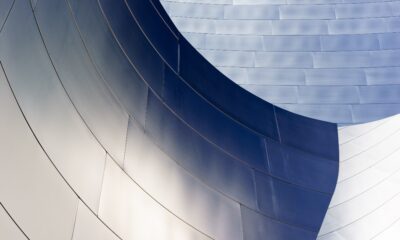
 Nyheter2 veckor sedan
Nyheter2 veckor sedanEurobattery Minerals satsar på kritiska metaller för Europas självförsörjning




